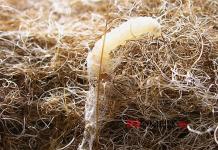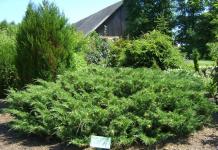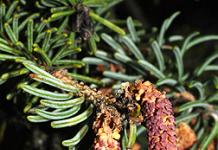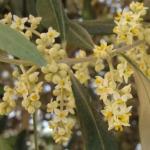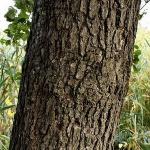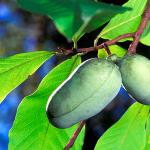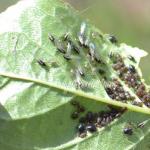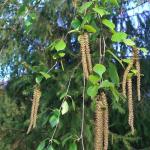29.10.2015
Moth is a very unpleasant pest that prefers to settle inside the house or in the garden. An inconspicuous-looking butterfly causes significant damage to horticultural crops, woolen items and fur coats stacked in a closet, and food. To date, more than 30 varieties of moths are known. All of them harm household property, and therefore, for owners who have discovered such unpleasant guests, the question of how to deal with moths at home becomes relevant. Actually, our article is devoted to this topic.
Varieties of moths by habitat
There are a lot of ways to deal with moths, and the reason for this is the diversity of the insects themselves and their habitat. In order to choose really effective preparations for removing a pest butterfly, you need to know where it can live and what damage it does in its area of location.
domestic moth
A distinctive feature of the domestic moth butterfly is that it practically does not eat anything inside the dwelling. When this insect enters the house, its main goal is to create oviposition. The moth caterpillars that subsequently appeared from the larvae become the very pests that damage furniture, dresses, fur coats and food products. Moth larvae are quite voracious. And therefore, when these unwanted guests appear, the first thing to do is to get rid of the egg-laying and caterpillars.
It should be noted that moths, which differ in their food preferences, more often settle inside a house or apartment. This:
- Fur moth. It is a yellowish butterfly of small size, with a slight sheen on the wings. Its larvae are worm-shaped, white in color and translucent skin. Their main source of food is fur from a fur coat, collar or hat. The reproduction of the insect occurs quickly, and after it a large number of ovipositions remain on the fur products. After a few days, larvae appear from them, undermining the fur product and making it unsuitable for further wearing.
- Butterfly furniture moth has a light yellow color, and reaches 10 mm in size. a distinctive feature of the insect are wings brown at the base. The furniture moth lays eggs on the underside of furniture, in small cracks in wood, at the bottom of upholstery or under it. Furniture moth larvae eat furniture upholstery and padding, and then move on to wood, making moves in it parallel to the pattern.
- The clothes moth is slightly larger in size than other types of indoor pest. Its wingspan can reach 22 mm. the wings of this butterfly themselves have a purple hue at the base, and light yellow in the center. Clothes moth larvae are similar to coat moth caterpillars, but they can often be seen on fabric materials (dram, cloth, wool). The clothes butterfly lays eggs on the inside of clothes made from the above materials. The larvae emerging from the eggs gradually gnaw through the tissue, leaving only a thin layer on top intact.
- Carpet moth belongs to the most resistant varieties of these insects. The larvae of this butterfly can eat not only carpets in the house, but also fur coats, leather items (jackets, shoes, bags, etc.). The carpet moth lays eggs in the depths of the fleecy part of the coating, preferring inaccessible areas (for example, located under furniture, covered with the backs of chairs and sofas).
- Food moth. This pest can most often be found in bags with bulk food products (dried fruits, cereals). Most often, cereals brought from the market become the source of food moths. Improper storage conditions there ensure the appearance of food moth larvae. Even if cereals and bulk products are placed in a sealed jar with a tight-fitting lid, this will not help protect against the appearance of a harmful insect. Moreover, the lack of ventilation also contributes to the spread of moths.
Moth living in the garden
The moth living in the garden causes a lot of harm to agricultural crops. Its appearance entails a noticeable decrease in fruit yield, damage to potato tubers and cabbage heads. This butterfly can live on:
- fruit trees and shrubs;
- in potato tubers;
- On heads of cabbage;
- On fruit;
- In grain crops;
- In wax;
- In house mushrooms.
Ways to fight
Having found a moth in his home, the owner is often at a loss and bewilderment, not knowing how to properly, and most importantly, effectively deal with such an insect. Getting rid of an unwanted butterfly should begin only after determining its variety. Each type of moth has its own methods of exposure and preparations.
With a fur coat
Advice! If suddenly moths scattered around your home, try looking into the nooks and crannies of your wardrobe. Perhaps there you will find an old woolen thing that has become a breeding ground for a pest and a place for eggs and larvae to accumulate.
Moth butterfly egg-laying is immediately noticeable, despite its small size. It has a white color and is often located on the surface of things.
Having found a pest butterfly in the house, every housewife will probably think about how to save a fur coat from moths. The best way in this case would be to carry out preventive measures, which include the following actions:
- With the onset of spring, it is necessary to carry out a general cleaning in the house, throwing out unnecessary and old things that can become a wonderful delicacy for a butterfly.
- Before putting them in storage, winter things are well ventilated, cleaned, dried, and then treated with a special moth spray. Now such drugs are presented in a wide range and help to fight not only the butterflies themselves, but also their larvae and eggs.
It should be understood that if the moth eggs are not removed in a timely manner, then after 10 days white larvae will hatch from them. They cause serious damage to fur clothes.

If the fur coat moth still wound up in your things, then it should be destroyed immediately. Fortunately, now there are many means and chemicals to combat such an insect. And if you still don’t know how to get moths out of a fur coat, we suggest that you familiarize yourself with the most effective means that currently exist:

With food moth
The appearance of food moths in the kitchen is not uncommon. Such a guest is unlikely to be interested in woolen things, but food will be her favorite delicacy. Getting rid of food moths forever is much more difficult, and often it is not possible at all.

The moth, which prefers to live in loose food products, has a large body size, and it can be recognized by wings with black spots. The appearance of this insect in the house is facilitated by low-quality products purchased on the market or in a store. Most often, an unwanted guest settles in cereals or flour. Butterfly larvae can live for several months completely on their own, not receiving food at all. The main sign that food moths have started up in your cereals is the presence of cobwebs and tiny worms (these are food moth larvae).

If such a misfortune was found, we recommend that you immediately review all bulk food products. If there were medicinal herbs next to the cereals, they should also be sorted out. If you find larvae in any product, immediately take it to the trash. To completely get rid of the insect, you should treat the cabinet in which cereals, dried fruits and bulk products were stored with an vinegar solution. Its pungent smell will drive away the remaining pests and block their path to food for a long time.
Attention! In order to prevent the appearance of food moths, try to store cereals in glass containers with tight-fitting lids.

With wax moth

The large wax moth becomes a real problem for beekeepers and beekeepers. The appearance of such an insect nullifies all work. The moth simply eats all the combs with honey reserves, leaving the beekeeper with nothing. Most bee lovers try to protect themselves and their pets from the attacks of such a pest in advance, looking for recommendations that will let them know exactly how to deal with wax moths in hives. Every beekeeper should remember that honeycombs should be stored in a well-ventilated place where there is natural air circulation. The best option for storing honeycombs would be dense cases in which beekeeping tools are placed on top of each other.
Before removing combs for long-term storage (after the end of the honey collection season), it is advisable to fumigate them with sulfur. Also, in order to prevent the appearance of wax moths, approximately 150 ml of carbon disulfide or 50 mg of formalin should be placed in the hives. In addition, professional beekeepers are well aware that butterflies and wax moth larvae are unlikely to appear if the combs are well sprinkled with entobacterin.
Useful properties of wax moth
The wax moth, which is also popularly called the moth, has one amazing feature. Her body is the only one in the world capable of digesting beeswax. This butterfly, penetrating inside the bee hive (where bees must live), lays eggs there, from which larvae then appear. They feed on the wax from the honeycombs. Interestingly, a long time ago, beekeepers considered this insect a pest, and today the wax moth belongs to therapeutic agents. Many readers now probably have a question - what does the wax moth treat and due to what, in fact, does such treatment occur? The fact is that even Mechnikov discovered a special enzyme that is present in the body of this insect and has a detrimental effect on mycobacterium tuberculosis. Yes, yes, wax moth for tuberculosis is the most useful remedy. A special tincture is made from the larvae of this butterfly, which is then used to cure. The composition of the larvae of the moth contains the enzyme cerrase, which contributes to the dissolution of the walls of bacteria that cause irreparable harm to the human body. Doctors have noticed that it contributes to the splitting of not only Koch's sticks, but also various viruses with cancer cells.

The wax moth larvae also contain polysaccharides and monosaccharides (including galactose and fructose), as well as fatty acids and amino acids that have a beneficial effect on the regeneration of old cells.
There are many indications for the use of tincture based on moth larvae:
- Asthma, bronchitis. The drug improves expectoration and drainage function of the lungs. Preparations based on wax moth larvae are allowed to be used in the treatment of chronic and acute bronchitis (not only in adults, but also in children).
- Tuberculosis. The cerrase enzyme already noted above, produced by moth larvae, has a powerful effect on the walls of Mycobacterium tuberculosis, causing their destruction and making them more vulnerable to the immune system and drugs. Treatment of people suffering from tuberculosis with wax moth tincture does not entail the development of complications and the destruction of microorganisms beneficial to humans (as is the case in the treatment of tuberculosis only with pharmacological agents).
- postoperative recovery. The serotonin proteases present in the moth larvae prevent the formation of postoperative adhesions and scars. Wax moth tincture will be useful for postoperative patients who have poorly fused sutures, or have extensive purulent inflammation.
- Infertility. Wax moth also has an excellent effect in case of violations of the reproductive functions of men and women. A drug based on it helps to increase erection and sperm activity in males, and in females, tinctures from moth larvae make the vaginal microflora healthy and improve the working functions of the ovaries. A good effect is given by medicines based on wax moth during pregnancy. They supply a large number of microelements and vitamins to the blood. The use of such drugs eliminates the risk of anemia in the expectant mother.
- depressive states. The wax moth larvae contain serotonin components that are responsible for improving mood and performance. A tincture of moth larvae can be used by people prone to depression and ordinary citizens during periods of autumn or spring blues. The composition of this tool is so useful that it will help not only to cope with a bad mood, but also to protect your body from the effects of respiratory infections.
Separately, it is worth mentioning where to buy wax moth tincture? It is clear that it is unlikely that it will be possible to cook it at home (unless you are the owner of the apiary). The distribution of such a drug is carried out by pharmacies, as well as by the beekeepers themselves. When preparing such a tincture for sale, it is important to understand that only moth larvae that have not yet reached the stage of pupation are suitable for it. Following this rule is extremely important, because just before pupation (the interim period before the caterpillar becomes a butterfly), the larva stops consuming food and its body is not saturated with useful components. Naturally, such individuals do not carry any therapeutic effect. When buying a wax moth-based medicinal solution, pay attention to the presence of instructions with recommendations for use. If there are none, then it is better not to purchase the tincture, since, most likely, it is a fake.
With furniture moth
You can deal with furniture moths in various ways. The measures taken will depend on whether pests have already appeared or not. Preventive methods of control are aimed at preventing the appearance of furniture moths, and liquidation methods are aimed at getting rid of already existing insects.

Among the liquidation measures to combat moths in furniture, the following can be identified:
- Mechanical removal of moth larvae and eggs;
- Warming up furniture and processing it with a quartz lamp;
- Treatment with aerosol insecticidal preparations.
Preventive methods of dealing with furniture moths in rooms include regular airing of the premises, periodic cleaning and washing of furniture, and their treatment with disinfectants.
Naphthalene balls can be used to effectively remove adult butterflies. This tool has long proven itself on the good side, but still has a serious side effect in the form of the presence of carcinogens that are harmful to human health.
The fight against moths that have already appeared on furniture consists in the mechanical removal of butterflies, egg-laying and larvae, as well as washing furniture. An additional effect is created by chemicals that are divided into fumigation and contact.
Contact preparations are represented by various aerosols, insecticidal solutions. They are applied directly to the moth-affected furniture surface. The larvae, crawling along the surface treated with such means, will eat toxic substances and soon die from them.
Fumigation preparations for combating butterflies and moth larvae are presented in tablets and plates. They are placed in the places of the alleged location of the moth and its larvae. The destruction of insects occurs due to aromatic fumes emanating from these preparations. Now manufacturers of insecticides against moths offer customers the widest range of their products. The category of aerosols includes Raptor "Moth protection", "Armol expert", "Mosquitol". The most effective plates against pest butterflies are considered Dezmol and Antimol. To protect upholstered furniture and carpeting in the room, Morimol, Foxid, Mittox, Supromit solutions will also help.
With potato moth

Potato moth is one of the most dangerous pests of potato tubers. It is worth taking measures to combat such a pest during the period of growing potatoes, as well as after harvesting, during its storage. The potato moth is a small grey-brown insect. Its larvae gnaw long passages inside potato tubers, causing a gradual blackening of the fruit.

Faced with a similar problem, most gardeners do not know how to deal with potato moths. It is extremely difficult to remove this pest, so you should prepare in advance and properly prepare for storing potato tubers. The procedure for the destruction of these insects should be carried out systematically and comprehensively, in accordance with the following principles:
- Healthy potato tubers should be planted to the maximum possible depth, after warming them up.
- Potato plantings are recommended to be regularly hilled and loosened.
- Potato tops must be mowed and destroyed in a timely manner.
- Immediately after harvesting potatoes, it is worth treating it with special anti-moth products. Such potato pests will not be able to resist Entobacterin, Dendrobacillin and Lepidocide. Well-proven in the fight against potato moth and preparation for processing potatoes Prestige.
- Potato harvest is recommended to be stored at a temperature of 3-5 ºC to avoid the appearance of butterflies and moth larvae.
Thus, the measures combine chemical and agrotechnical measures. It is necessary to take care in advance of preparing a place for storing potatoes, clearing it of any debris. Potato storage should be not only clean, but also well disinfected. Before storage, it is advisable to clean the tubers of obvious dirt and dry them in the open air.
In the event that moths still start up in the storage where potatoes are stored, you can try to use the so-called sulfur checkers for greenhouses. When such a pellet is burned, a gas called sulfur dioxide is released into the air. It has a detrimental effect on the body of an insect pest. Sulfur is burned in the basement where potato tubers are stored, at the rate of 50 per 1 m 3. The scope of sulfur checkers is not limited to cellars. They are also used to disinfect polycarbonate greenhouses, houses and warehouses. Fumigation of the cellar with a sulfur checker allows you to dry the cellar and prevent the development of mold, rot and fungal diseases in it. You can buy such a device in a specialized store or make it yourself by watching a video on how to make a smoke bomb.
With apple moth
– a very serious pest for garden trees. Such a moth harms not only apple trees, but also other fruit trees (plums, apricots, cherries, pears).

A distinctive feature of the apple moth butterfly is the light gray or white color of the wings. The caterpillar of this pest has a greenish color and two rows of black dots. It is the caterpillars of the moth that cause the appearance of cobwebs on the leaves of the trees, which subsequently destroys all the foliage on individual branches. If a small tree is severely affected, then there is a risk that it will completely lose its vegetative parts.

Irreparable damage can be caused to gardening by pests of fruit trees and the fight against them should therefore begin as early as possible.
- Before flowering, it is desirable to treat the trees with insecticidal agents.
- To control the presence and quantity of apple moths, it is recommended to hang traps for insect pests on fruit trees around the garden.
- Moth-infected leaves of an apple tree or other trees must be collected and destroyed in a timely manner.
- The natural enemies of the apple moth are braconid wasps. They should be brought into the garden when pests are found.
- If necessary, you can additionally apply chemicals.
With chestnut moth

The main measures to combat the chestnut moth are tree feeding, the introduction of special chemicals into the vessels of the tree, the basis of which is Imidacloprid. This component saturates chestnut leaves with substances poisonous to moths. A good effect is also given by the method in which the so-called rider-trichogramma sits down to the larvae.
With ermine moth

Ermine moth is an insect from the Lepidoptera family, which includes more than 600 species. Most often, varieties of ermine moths are found in the tropics, but some of them have adapted to life in Russia. The main source of nutrition for the ermine moth is vegetation (mainly leaves, less often roots). Settling on the stems and leaves of vegetation, the caterpillars of this butterfly rather quickly entangle them with cobwebs, stopping the supply of nutrients. On one tree, several hundred caterpillars can exist independently of each other. The ermine moth causes great harm to agriculture and forestry. On the territory of Russia, this kind of harmful butterfly can be found on apple and bird cherry trees. Depriving the plant of leaves, this insect provokes a slowdown and complete cessation of its growth, lack of fruiting and flowering.
The main method of combating ermine moths will be timely prevention and treatment of the tree with chemical insecticidal preparations or biological agents. If the area affected by the tree is small, then the nests of moth butterflies can be collected manually, and the leaves damaged by the pest can also be collected. Then they are burned along with the larvae outside the garden plot.
Among the most effective insecticidal preparations used to combat ermine moths, one can note:
- Arsenic solution;
- Bordeaux liquid;
- Danadim;
- Lepidocid;
- Bitoxibacillin;
- Aktellik (for private horticultural farms).
The first treatment is carried out in May, while caution should be exercised, since the above remedies are extremely toxic. You can process the plant again in early July.
There is also a folk method of dealing with ermine moths. A solution is being prepared, the basis of which is a bucket of water, in which a pack of shag tobacco, a bag of red pepper, onion and garlic husks, and a bottle of potassium permanganate are diluted. The prepared mixture is insisted for three days, and then sprayed onto the trees. Such a drug can be replaced with ordinary Coca-Cola.
With poplar moth

The poplar moth is a small white butterfly that is predominantly nocturnal. It harms agricultural products, but mainly settles on green plantations of poplars of various types. The color of the poplar moth is inconspicuous, but there is a slight variegation on the front wings. The caterpillar of this pest does not exceed 5 mm in length.
As for the methods of dealing with poplar moths, it is worth considering here that this pest does not cause any damage to a person. True, sometimes moths cause inconvenience, settling on the ceilings and windows of dwellings. The main means of combating poplar moth is now spraying poplar crowns and the soil around their plantings with the strongest pesticides.
Dealing with whiteflies
The whitefly is a harmful insect of small size and white color. These butterflies are localized on the inside of the leaves of trees, and therefore they are practically invisible.

To understand how to deal with the whitefly at home, the gardener needs to be familiar with the main signs of the presence of insects on the plant:
- When touching the stem and leaves, whitefly butterflies immediately take off from under the bottom.
- On the underside of the leaves, where butterflies accumulate, there is a sticky coating in which mushrooms reproduce. Because of them, the leaf first acquires a white tint, and then gradually turns black.
- Whiteflies carry viral diseases from plant to plant, causing deformations of stems, leaves and cessation of shoot growth.
If vegetable or other cultivated plants of the garden are affected by the whitefly, then the main measure to combat it will be their treatment with insecticidal agents. Actellik, Confidor, Fufanon, Pegasus, Fosbecid will be effective in this case. The number of sprays and recommendations for diluting preparations can be found in the instructions for them.
The whitefly causes great harm to agricultural lands and the fight against it must be of high quality, effective and timely. Folk remedies against whiteflies have proven themselves well. It should be remembered that such pests react extremely poorly to cold, so a plant affected by this type of moth can be transferred to a cooler room for prevention purposes. But at the same time, it is worth clarifying whether such a movement will negatively affect the vegetation itself.
The so-called glue traps against whitefly moths have gained great popularity among gardeners. An ordinary plywood sheet is painted bright yellow and smeared with a layer of adhesive (honey, castor oil or rosin) on top. The bright surface will attract butterflies, and the glue will keep them from flying away. Regular sticky fly tapes can also be used as moth traps.
There are more neutral ways to deal with the whitefly. They are used if the whitefly is wound up in indoor flowers. Helpful in this case:
- Infusion of yarrow. The leaves of this plant are taken in the amount of 80 g per 1 liter of water and infused for one day. Large leaves of plants are wiped with a cotton swab, and flowers with small leaves are sprayed.
- Infusion of garlic. Add a tablespoon of finely chopped garlic to a liter of water. It is necessary to insist the composition for one day.
- 1 part of crushed soap is dissolved in 6 parts of water, and then the leaves of moth-affected plants are wiped with the finished solution.
Fur coat storage rules
It is possible to prevent the appearance of moths and its larvae in fur things if you properly store clothes in the off-season. Most often, moth larvae start up in outerwear made of natural fur, and therefore we will give a number of rules regarding how to store a mink coat in the summer.

- The best option for storing a natural mink coat is a bag made of breathable material. It is desirable that it was not made of polyethylene. It is better, of course, to buy a cover for a fur coat. Before being placed in it, the fur product should be hung on wide hangers. In general, such clothes are recommended to be stored in a dry and slightly cool place, separately from other things. This will ensure normal air circulation in the storage area and prevent the appearance of pest butterflies.
- Ordinary newspapers will help protect a valuable fur coat from moths and other pests. Before being placed in a bag, the product is folded and wrapped with newspapers. To increase the effectiveness of such preventive measures, along with a fur coat, you can wrap tangerine peels from moths, tobacco, lavender or hot peppers in the same place. All these products have a pungent odor that the harmful butterfly does not like. For a person, the aroma of these natural remedies will be pleasant and unobtrusive. This option will help not only to establish an effective fight against moths, but also to freshen the air in the room.
- When laying a fur coat for summer storage, pay special attention to the choice of hangers for it. Most of all, wooden or plastic trempels are suitable for natural fur products. The length of the coat hanger for a fur coat should correspond to the length of its shoulder.
- If you are financially able, then you can store a mink coat in the summer in a special refrigerator, which is now available in many dry cleaners. The moth is very afraid of the cold and will never encroach on fur stored at sub-zero temperatures.
- If the fur product is stored at home in a closet, then it is advisable to regularly take it out for ventilation. In winter, the fur coat is ventilated naturally, while wearing, then in the summer it needs to be forced to provide such a procedure. But at the same time, you should take care that the fur is not exposed to direct sunlight.
- In order for a natural mink coat to serve you as long as possible, do not wash it in water using a variety of detergents. This cleaning method is categorically unacceptable for any fur product, as it leads to a significant deterioration in its appearance. The villi of the fur stick together under the influence of a humid environment, and as a result, the whole fur coat looks unpresentable.
- You can not dry a fur coat with a hair dryer or placing it near a heating radiator.
- If the fur is dirty, then it can only be cleaned in a specialized institution called dry cleaning. You should also not comb the fur against the growth of hair, and also try to beat the dust out of it with a carpet beater. Such exposure often leads to the fact that fragile villi break.
The first thing that comes to mind when you hear the word “moth” is a butterfly, often found in poorly ventilated closets, spoiling clothes and other textiles. However, there is also a plant pest moth - no less dangerous and causing great damage to garden plantings. This article is devoted to how to deal with moths in the garden, and how to protect plantings from the invasion of these pests.
How to deal with kidney and rowan moth
Fruit crops such as currants and gooseberries are harmed by caterpillars. kidney moth. In the spring, after wintering, they begin to feed on kidney tissues.
Damaged kidneys look like burnt, dry up. In addition, after the leaves bloom, damaged shoots are noticeable.
To protect plants from moths, pruning and burning of affected shoots, collecting fallen leaves and cocoons should be carried out. In the fight against caterpillars, spraying plants with a decoction of tobacco grass helps.
How to deal with the upper-sided moth on an apple tree
This pest is a small butterfly that damages the leaves of all fruit trees, especially apple trees. Wintering of the moth caterpillar takes place under the fallen leaves, in the cracks of the bark. In spring, the moth is able to lay up to 30 eggs on the upper side of the blossoming leaves. Caterpillars eat holes in the pulp of the leaf without damaging the skin of the leaf plate. Their pupation takes place in spider cocoons on the underside of the leaf. In this case, the sheet is pulled together and bent.


To combat the upper-sided fruit moth, it is necessary to collect and destroy caterpillar colonies along with spider nests. In autumn, you should rake fallen leaves and dig up the soil near the trees, clean the bark from moss and dead particles, and whiten the trunks.
How to deal with moths on an apple tree when a large number of pests invade? It is recommended to spray trees before flowering with insecticides, but most drugs are only effective against young caterpillars.
When working with the sprayer, the jet of liquid should be directed to the underside of the leaves.
The distance between the sprayer tip and the treated surface should be at least 0.5 m. It is better not to hold the jet in one place, otherwise the liquid will begin to drain.
Protection against grape circle moth
This pest is a butterfly with a wingspan of 4 mm. Its front wings are brown with white spots. Hindwings dark brown. The fringe of the wings is long, gray-white. Antennae filiform. Caterpillar 3 mm long, yellow. The pupa is 2.5 mm in size, light yellow.


The wintering of caterpillars that have completed feeding takes place under the lagging bark. In April, pupation occurs, and after 10-12 days, butterflies fly out, whose life expectancy is about a week, so soon after departure they mate, females begin to lay eggs, placing them on the veins of the leaves.
The revival of the caterpillars occurs after 5-7 days. Then they begin to feed, biting into the middle of the leaf and making rounded holes with a diameter of 1.5-2 mm. After the development of the caterpillar is completed, after 8-10 days, butterflies of the second generation fly out.
The mass years of the first generation are observed in June, the second - in July, the third - in September. With significant damage, the leaves fall off. Caterpillars of the last generation, after feeding, move to wintering grounds.
To protect against grape circle moths, it is recommended to strip the dead bark and burn it.
How to deal with cherry shoot moth
This pest is a small brown butterfly with a wingspan of 1 cm.


Cherry moth caterpillars up to 6 mm long, greenish-yellow. Cherry shoot moth damages and destroys the buds, flowers and leaves of cherries and cherries.
Wintering of the caterpillars takes place in the cracks of the bark, near the fruit buds of the tree. They come out during the swelling of the kidneys and bite into them, which leads to further drying of the kidneys. Then the caterpillars move on to young leaves and buds, nibbling them and leaving behind a thin cobweb with excrement.
Cherry shoot moth caterpillars can penetrate young shoots, causing them to dry out.
At the end of the flowering of cherries and sweet cherries, the caterpillars move to the upper layers of the soil of the near-stem circle, where they pupate. During this period, it is recommended to loosen and dig the soil under the trees.
In July, butterflies appear and start laying eggs.
Symptoms of cherry moth damage to a plant are often confused with signs of tree freezing.
To prepare it, it is necessary to pour 600 g of dry yarrow herb into 8 liters of water, boil for 30-40 minutes, then cool, strain, add 2 liters of water, let it brew for 2 days. Dissolve 40 g of soap in a decoction before use.
How to get rid of ermine fruit moth
This pest is a butterfly with a wingspan of 18-22 mm. The forewings are white with black dots. Hind wings grey. Egg size 0.3 mm, yellowish, rounded. Caterpillar 14-16 mm long, yellow-gray. The pupa is 8-11 mm long, dark yellow, and its head is black. Cocoon thin, white.


Ermine fruit moth damages plum, cherry plum, apricot, cherry, sweet cherry, mountain ash, apple tree.
Wintering of caterpillars takes place under the shield. At the end of April, they come out from under it and immediately begin to weave spider nests, connecting the leaves in pairs. Their development continues for 1-1.5 months.
Pupation in spider web nests occurs separately from each other. After 8-10 days (at the end of May - beginning of June), butterflies appear. Their years last until mid-August. 2 weeks after the release, the butterflies begin to mate, after which on the 5-6th day they begin to lay eggs. The female lays 15-40 eggs on the smooth bark of thin branches and fills them with mucus, which quickly hardens in the air.
After 8-15 days, the caterpillars are reborn, which then remain under a moisture-proof shield until the next spring. In spring, the caterpillars begin to damage the leaves and braid the tree branches with a thick cobweb. With significant damage, the quantity and quality of the crop decreases, the growth of shoots decreases, and the process of formation of fruit buds is disrupted.


To combat the ermine fruit moth, it is recommended to spray the trees with a decoction of marigolds and wormwood. To prepare it, it is necessary to pour 200 g of dried chopped marigold grass into 5 liters of water, boil for 1 hour. Then pour 5 liters of water 200 g of dry chopped herb wormwood, boil for 20 minutes. Cool decoctions of marigolds and wormwood, mix, strain, add 2.5 liters of cold water. Processing is carried out 2-3 times during the budding of plants.
How to deal with onion moth
This pest is a small butterfly whose wingspan does not exceed 1.5 cm. Its front wings are brown with white spots, the hind wings are light gray with long villi. Caterpillars up to 1 cm long, green, with short hairs. The head of the caterpillars is brownish.
Butterfly season begins in May. At the same time, they lay their eggs on the lower surface of the leaf, and sometimes on the soil near the onion plants.
A week later, caterpillars appear, which begin to bite into the flesh of the leaf without damaging its skin. Moves are formed that are clearly visible on the leaves.
After 15 days, the caterpillars leave the leaves and pupate, after another 20 days, moth butterflies of a new generation fly out.


Onion moth strikes, and. Damaged leaves begin to turn yellow, then dry up and die. There is a decrease in yield.
An effective way to deal with onion moths is to spray plants with an infusion of garlic and calendula seeds. To prepare it, you need to mix 4 cups of calendula seeds and 100 g of minced garlic. Pour 10 liters of boiling water over the resulting mixture, leave for 3 hours.
Spraying should be done every other day in the evening. Processing must be stopped 30 days before harvest.
In the photo Apple moth fruit leaflet  In the photo Caterpillars of the apple moth
In the photo Caterpillars of the apple moth
Apple moth fruit leafworm, or apple moth Simaethis pariana Cl. (syn. Anthophila pariana Cl.,),- a small butterfly with a wingspan of 10-12 mm.
The caterpillars are yellowish green, have a light brown head and shiny dots on each segment of the body. Body length 12-13 mm. They live alone, skeletonize the leaves from the upper side, in case of danger they immediately leave the leaf, going down the cobweb. Two generations of the pest develop per year. The most harmful is the second generation, which develops in late summer - early autumn and whose caterpillars cause massive damage to the leaves before drying out. Premature fall of leaves negatively affects the maturation of shoots and their frost resistance. Having finished feeding, caterpillars of the second generation pupate, butterflies soon emerge, which, with the onset of frosts, hide and overwinter until the next year. The pest is ubiquitous and damages all fruit and many berry bushes.
See what an apple moth looks like in a photo illustrating the different stages of pest development:


Control measures. Spraying in the spring, before full bud break and immediately after the end of flowering of apple trees, with Fufanon or its analogues (Kemifos, Karbofos). With a large number of caterpillars of the second generation, repeated sprayings with the same preparations are carried out at the end of summer or at the beginning of autumn, taking into account the waiting time for each specific preparation. Collection and burning of fallen leaves.
 In the photo Moth moth pocket edge
In the photo Moth moth pocket edge  In the photo of the caterpillar moth moth
In the photo of the caterpillar moth moth
Moth moth pocket marginal, or moth moth apple silvery Ornix guttea Haw., - a very small butterfly with a wingspan of 12-13 mm. The forewings are narrow, dark brown with white silvery spots and a long delicate silvery fringe. Caterpillar up to 5 mm long, with 7 pairs of legs, green, lives in pockets from the curved edges of the leaf and skeletonizes the leaf from the underside. During the year, two generations develop - summer and autumn. Caterpillars of the second generation, which are more numerous, cause significant damage.
Control measures.Spraying trees immediately after flowering with one of the preparations: fufanon, kemifos, kinmiks, actellik, spark, Inta-Vir. With a large number of pests, spraying is repeated in the summer with the same preparations, taking into account the waiting time.
 In the photo Moth-moth apple-mining
In the photo Moth-moth apple-mining  In the photo, the caterpillar of the moth moth
In the photo, the caterpillar of the moth moth
Moth moth apple-mining Lithocolletis pyrifoliella Grsm.- a very small butterfly with a wingspan of 8-9 mm. The wings are narrow, long, with a delicate silver fringe. The caterpillar is small, yellow-green, lives inside the leaf, feeds on the parenchyma and forms a characteristic mine. Mina on the upper side of the leaf in the form of a wide oval spot up to 2.5 cm long, yellowish-brown, vesicular, located along the veins. Excrement is usually located in the form of a lump in the central part of the mine. 1-3 generations of the pest develop per year.
Control measures.
 In the photo Moth apple ermine
In the photo Moth apple ermine  In the photo of the caterpillar of the ermine moth
In the photo of the caterpillar of the ermine moth
Moth apple ermineYponomeuta malinellus Zell. - a small butterfly with black dots on the front wings, the hind wings are silver-gray. Caterpillars 17-18 mm long, yellow-white to dark gray, with two rows of black dots on the back. Caterpillars live in colonies, forming web nests. Younger caterpillars hibernate in egg-laying under shields. In the spring they bite into the buds, and then into young leaves, where they feed for 10-15 days. During the flowering of the apple tree, the caterpillars crawl out of the leaf blade and create a cobweb tent from several leaves that they feed on. Each brood can have up to 70 caterpillars, which during their feeding (35-40 days) constantly crawl to neighboring branches and form new nests. Having finished feeding, the caterpillars pupate inside the common nest in separate white cocoons. In June, white butterflies fly out, and after fertilization, the females lay their eggs in clusters in the form of shields. One female can lay from 20 to 100 eggs. Hatching caterpillars feed under the shields, nibbling the bark, and enter diapause until the next spring. The apple ermine moth is ubiquitous and greatly harms apple orchards.
Control measures. Preventive spraying of trees during bud break and immediately after flowering with one of the preparations: Fufanon, Kemifos, Kinmiks, Aktellik, Spark, Inta-Vir. Separate nests with caterpillars are cut and destroyed. With a large number of sprayings, repeat with the same preparations.
How to deal with fruit ermine moth on an apple tree
 In the photo Moth fruit ermine
In the photo Moth fruit ermine  In the photo, the caterpillars of the fruit moth
In the photo, the caterpillars of the fruit moth
Moth fruit ermine Yponomeuta padellus L. (syn. Y. variabilis Z.)- a small snow-white moth with black dots on the front wings and a gray fringe on the vernal edge. The hindwings are silvery grey. The eggs are oval, gray in color, arranged in ovipositions in the form of shields 4-7 mm in size. The caterpillar is 17-18 mm long, from dark gray to yellow-white in color, has two rows of black ones under the shields on the back and damages the buds and young leaves from early spring, skeletonizing and eating them around the edges, causing the leaves to dry out half. During the flowering of the apple tree, the caterpillars weave cobweb nests and live in colonies of 20-70 pieces.
Having finished feeding, after 35-40 days the caterpillars pupate, each in a separate white cocoon, and these cocoons are scattered throughout the branch. The cocoons are thin, transparent, a striped chrysalis is visible inside. The head, thorax and end of the abdomen are black, while the main part of the abdomen is bright yellow with a row of dark triangular spots. In June, butterflies come out, feed on nectar, females lay eggs in clusters in the form of shields on branches. The fertility of females is 20-70 eggs. Hatching caterpillars gnaw the bark under the shield and enter diapause until the next spring. It damages all stone and pome crops, mountain ash, bird cherry, willow, ash and oak.
How to deal with ermine fruit moth on an apple tree is described in the previous paragraph.
Pocket mining moth on apple trees how to fight
 In the photo Moth pocket miner
In the photo Moth pocket miner  In the photo, the caterpillar of the pocket moth
In the photo, the caterpillar of the pocket moth
Moth pocket miner, or moth pocket white-spotted Ornix petiolella Frey (syn. Parornix petiolella FreyJ, is a small gray butterfly with a wingspan of up to 12 mm. The front wings are very narrow, gray, with numerous oblique light strokes, the hind wings are light gray, with a long delicate fringe. Caterpillars are very small, yellow-green, with 7 pairs of legs, live in white rounded mines under the upper skin of the leaf, eating away the parenchyma. The length is min 10 mm and the width is 5 mm. It damages the leaves of the apple tree, less often the leaves of the pear and stone fruits.
How to deal with moths on apple trees is described further on the page - use all available means and methods.
Control measures
 In the photo Moth hawthorn circle
In the photo Moth hawthorn circle  In the photo, the caterpillars of the hawthorn moth
In the photo, the caterpillars of the hawthorn moth
Moth hawthorn circle Cemiostoma scitella L.. - a small butterfly with narrow wings and a long delicate fringe. Confused in the leaf parenchyma, forming mines. Mines in the form of small rounded wide spots of dark color, usually several on a leaf, excrement arranged in a spiral is visible through the skin. In addition to the apple tree, moths are often found on hawthorn, cherry, mountain ash.
Control measures. The same as against the pocket moth.
 In the photo Moth moth apple
In the photo Moth moth apple  In the photo, the caterpillars of the moth moth
In the photo, the caterpillars of the moth moth
Apple moth Lithocolletis pomiella Grsm. - a small butterfly with a wingspan of 8-9 mm. The wings are long, narrow, fringed with delicate fringe. The black caterpillar lives under the epidermis of the upper side of the leaf and feeds on the parenchyma, forming a mine. The mine is spotted, excrement is usually collected in the corner of the mine.
Control measures. The same as against the pocket moth.
 In the photo Moth-baby apple
In the photo Moth-baby apple  In the photo, the caterpillar of the baby moth
In the photo, the caterpillar of the baby moth
Moth-baby apple, or moth-baby apple miner Stigmella malelli Stt., - a very small butterfly with a wingspan of up to 5 mm. The wings are thin, narrow, lanceolate, with a fringe of long shiny hairs. Head covered with dense hairs, first segment of antennae expanded, wing venation reduced. The caterpillar is yellowish-white, flat, legless, and feeds on the parenchyma inside the leaf, making long, thin flagellate-like, often filamentous mines on the upper side of the leaves. It is ubiquitous and causes the greatest harm to the apple tree.
Control measures. The same as against the pocket moth.
 In the photo Moth-crumb apple white
In the photo Moth-crumb apple white  In the photo, the caterpillar of moth-crumbs
In the photo, the caterpillar of moth-crumbs
White apple moth, or apple miner moth Lyonetia clerckella L., - a small butterfly with narrow front wings of silver-gray or brownish color.
The top has a black ledge, and on the front edge - 3 black spots. Hind wings fringed. The caterpillars are light green, with a dark head and dark legs, body length is 5 mm. Butterflies of the second generation hibernate, and partly the eggs laid by them at the base of the kidneys. In the spring, caterpillars hatched from eggs bite into young leaves and feed there. Overwintered butterflies lay their eggs on leaves. The emerging caterpillars live inside the leaf blade and make narrow winding passages, filling them with their excrement.
Feeding lasts 20-25 days, the caterpillars gnaw a hole from the underside of the leaf and pupate near it in a white cocoon. After about two weeks, butterflies come out and begin to lay eggs on the leaves. In September-October, butterflies of the second generation appear, which overwinter. The crumb moth severely damages apple trees, stone fruits, mountain ash, hawthorn, shadberry, and many hardwoods in gardens.
Control measures. The same as against the pocket moth.
Irina Z.
How to get rid of moths in a house where there are a lot of moths from nowhere?
The appearance of moths in the house is not uncommon, so it is important for housewives to be able to deal with it. These harmful insects infest food, clothing, carpets, etc. As a result, the inhabitants of the house may lose a sweater or a fur coat, an interior item or flour supplies. To avoid losses, you need to know how to get rid of moths as quickly and efficiently as possible.
How does the moth appear in the house
There are more than 30 types of moths, among which furniture, fur coat, clothes, carpet, fruit, cereal, etc. are most often found. These insects up to 1.5 cm in size have a gray inconspicuous color. The greatest harm is caused not by adults, but by caterpillars and larvae that eat a huge amount of food.
Often, moths enter the house in several ways:
- flies in through a door or window;
- enters the apartment along with purchased items or products;
- penetrates into the house from neighbors through cracks, ventilation ducts or an entrance.

Finding the eggs of these insects is quite difficult, but adults that begin to fly are easy to spot. If the residents saw a small gray butterfly, then a pest has appeared in the house, which must be removed without delay.
Moth habitats
If a lot of moths fly in the house, but it is not known where it came from, then you need to urgently start searching:
- Inspect the cabinets where woolen, fur and other wardrobe items are stored. The presence of pests will be indicated by oblong cocoons, holes and fur bald spots in products.
- Consider furniture upholstered with natural fabrics. If insects are wound up there, then their tunnels-ways will be visible.
- Examine all carpet products made from natural materials, where bald spots, passages and cocoons can also be found.
- Make an audit of the products stored in kitchen cabinets. You need to inspect flour, cereals, dried fruits and look for lumps, glued grains, small worms and cobwebs. After determining the habitat of insects, all infected products should be thrown away. Then you need to thoroughly wash and dry the kitchen set.
Pest Control Methods
Heat treatment. The moth feels comfortable at ambient temperatures from -5°C to +45°C. Therefore, with a small degree of infection, the following methods will help to remove insects:

Moth does not tolerate high temperatures
- Steaming clothes or washing at maximum temperatures. To get rid of pests on carpets and furniture, you can use a steam generator or a special household hair dryer.
- Freezing the room for several hours.
Attention! Take the necessary precautions so as not to damage the heating system.
- Placement of fur products in the refrigerator.
Chemicals. Insecticide preparations successfully fight against clothes moth:
- Fumigators are not harmful to humans, but harmful to insects. Among the most popular means are "Raid", "DiK-3", "Mosquitall".
- Aerosols - have a strong toxic effect and can completely destroy pests. Usually, such means as “Protection against moths” (“Mosquitall”), “Armol”, “Raptor”, “Ekstramit”, etc. are used.
- Moth sections - often used only to prevent infection. The most popular are Mosquitall and Raptor.
Attention! If small children or people with allergic diseases live in the house, then it is better to fight pests with the help of natural remedies.
Folk remedies for pest control
Natural remedies that have a strong smell will help get rid of moths:
- geranium,
- dried lavender with flowers,

- laundry soap,
- sagebrush,
- citrus peels,
- tobacco,
- walnut leaves.
The listed funds need to be laid out on the shelves, which will repel insects and serve as a good prevention for the future.
Thus, various methods will help get rid of moths, the effectiveness of which has already been proven by practice. But it is best not to deal with the problem that has arisen, but to try to avoid it: regularly clean the apartment, ventilate cabinets, clean furniture and carpets, store cereals in carefully closed jars.
How to destroy a mole: video
Another distinguishing feature of this annoying pest is persistence. In an effort to get to a "delicacy" fur coat or woolen coat, the insect can easily overcome fabric and polyethylene covers. Accordingly, one should not rely on these methods of protection.
Another type of moth is food, it is distinguished by fertility. During its life cycle, the butterfly lays about one and a half hundred eggs, from which very voracious caterpillars later hatch. You can find them in the process of auditing on kitchen shelves or in cabinets. Not to notice the traces of the appearance of the pest is quite difficult. But there is simply no other method of dealing with moths, except for the complete disposal of the discovered clutches, in this case.

In rooms where ventilation is often performed, and things in cabinets do not hang idle for most of their "life", it is almost impossible to meet pests. Their best friends are dirt, dust, high humidity and lack of direct sunlight. Moreover, even if a pale cream butterfly was seen in the premises of a house or apartment, the fight against adults will not give a visible result. The thing is that they have no desire to damage things from natural materials. And the main danger is the larvae, which at the stage of pupation require a significant supply of vitality.
There is no effective "folk" or "home" remedy for the destruction of winged individuals. They can only be scared away from cabinets and food storage areas using a variety of substances and plants with a sharp aroma. But with the larvae, you can and should fight with all available means.


- Clothes and shoes put away in the closet are clean and dry. The fabric that has retained particles of human sweat and skin is a more tasty bait for the pest.
- You follow the rules of seasonal storage of wardrobe items. Fur coats, for example, are stored in special cases, hats - in cardboard boxes, scarves and hats - on special holders, shoes - without insoles.
- All storage areas are adequately ventilated, located outdoors with a high level of humidity, and regularly ventilated.
- Containers for storing cereals and other bulk food products have a sealed lid.
- Cleaning is done in a timely and thorough manner - grease, dirt, dust attract moths like a magnet, signaling that there is something to profit from in the room.
The fight against moths requires a considerable investment of time and effort. It is not worth adding to the enemy's chances of success by capitulating before he has time to attack. Make sure that your closets are always in order, and your clothes are regularly ventilated and stored in proper conditions. In this case, it will be much easier to defeat the pest.

Folk methods of struggle: fragrant salt, lavender and tangerine


How to deal with moths if you have already noticed the appearance of adult insects in the house? First of all, you should carefully check all the premises of the apartment for the detection of egg clutches. For preventive purposes, it is worth:
- inspect cabinets;
- dry feather beds and feather pillows;
- arrange ventilation in all possible habitats of insects.
In addition, it is worth taking care of preparing repellers that will not allow moths to even come close to clothes in the future. Of course, naphthalene immediately comes to mind, with its aroma quite capable of knocking down not only a flying insect, but also a person. The aroma of this substance until recently was considered perhaps the only defense against the invasion of voracious butterflies. But today the negative impact of the substances emitted by it on human health has been proven. That is why, for the purpose of prevention, it is better to use more gentle measures of influence. To scare away the moth will help:


- Plants with a strong aroma."Charms" hung in closets: sprigs of lavender, tansy, geranium, mint, carnations, will not only become a natural deodorant for clothes sent for long-term storage, but will also scare away uninvited guests. True, modern individuals here too have learned to overcome their natural aversion to strong odors and can take risks in order to lay their eggs in a particularly luxurious fur coat. And aromatic components do not act at all on the larvae.

- Fragrant soap. It works by analogy with other repellers. Notes of mignonette, lily of the valley, pine needles, citrus fruits are considered especially effective. Among the advantages of this method is the absence of marks on clothes that plants sometimes leave.

- Essential oils. Concentrated formulations easily cope with their purpose, scaring away moths within a radius of tens of meters. It is enough to put them on a napkin and send them to the closet. But the garments themselves should not be covered with oils - they leave greasy stains that are not very aesthetic and difficult to remove.
- Orange peel. The bright aroma released by the peel of citrus fruits as it dries serves as a natural deodorant and repels harmful insects. Zest can be used not only in wardrobes, but also in kitchen cabinets, which distinguishes it from all other means.
It is worth considering that in any case, it will not work to fight the moth without the use of radical measures of influence. Specialists of the company "ECO-CAPITAL" advise:

In the fight against adults, one should not forget that the main danger is the larvae. It is they who spoil clothes and carpets, gnaw through home textiles and are well camouflaged in the depths of cabinets and other pieces of furniture. You can't get by with a "cosmetic" effect. Cardinal measures are needed that can lead to the death of clutches of eggs and larvae at any stage of development. Otherwise, instead of your favorite clothes sent for seasonal storage, only worthless rags riddled with the mouths of voracious pests will remain in the closet.
Means of effective struggle: what is the mole afraid of
Before you deal with moths in an apartment, you need to identify its habitat. Clothes and linen individuals live in residential premises. Lovers of cereals and cereals - in the kitchen. It is from this factor that the choice of insecticide will depend in the future. In particular, you can use:

- Aerosol preparations. Dichlorvos and its analogues do an excellent job with flying insects and are poisonous to their larvae. True, spraying pesticides inside cabinets should still be done with precautions. And after some time after processing, all clothes will have to be thoroughly ventilated. Sprays are also not suitable for combating food species of moths. Here it will be much safer to use thermal exposure. However, there are also universal drugs - such as "Armol" or "Raptor".

- section elements. They are also called deodorants. Outwardly, they look like pieces of ordinary soap, they are hung up and laid out in cabinets in order to prevent and repel insects. Not poisonous to humans and animals. Produced by most major manufacturers.

- Electrofumigators. Like other agents of this spectrum, they are effective against flying insects. Moth control in this case will be effective only if adult insects have not laid eggs.

- Thermal impact. Like other insects, pests of this type are afraid of thermal exposure. The premises where the moth settled can be frozen out, thus killing the larvae, or treated with a steam generator. Ignite the cereals in the oven or in a dry frying pan.
How to get rid of moths in an apartment and house with the help of professionals

offer professionals? First of all - to abandon the ideas of herbal medicine. You can win here only with the help of proven insecticides. Moreover, even their experts suggest not spraying locally, wasting time and effort, but spraying in the form of a cloud of water suspension that can sink into the most inaccessible corners of the premises where a larva or adults can live.

This method is applied with the help of technical means called "fog generator". By supplying the insecticide from a pressurized tank, the specialist controls the treatment process in real time and can ensure the creation of a directed steam flow to the most dangerous areas in terms of insect larvae.
The hot mist generator combines the spraying of pesticides with thermal effects. This approach ensures the total destruction of all individuals and provides the longest and most effective protection in the future. However, you can take care of preventive measures in advance by ordering the installation of barrier protection with the help of special chemicals from the ECO-CAPITAL company.
Prevention measures

Upon completion of the work performed by professionals, the moth will leave your home for a sufficiently long period of time. And in order to avoid her return, you should remember to follow simple security measures:
- cereals and bulk products should be stored only in hermetically sealed containers;
- fur coats, sheepskin coats and coats must be cleaned before being sent for storage;
- clothes to be washed - handle at the highest possible temperatures;
- do not mix clean linen and clothes with dirty ones;
- regularly ventilate wardrobes and wardrobe items stored in them.
By following these simple rules, it is possible to avoid the reappearance of the moth where it has already been expelled. If the reason for creating favorable conditions for the reproduction of insects was the increased humidity in the dressing room, it is worth moving the cabinets to where they will be regularly exposed to direct sunlight.
